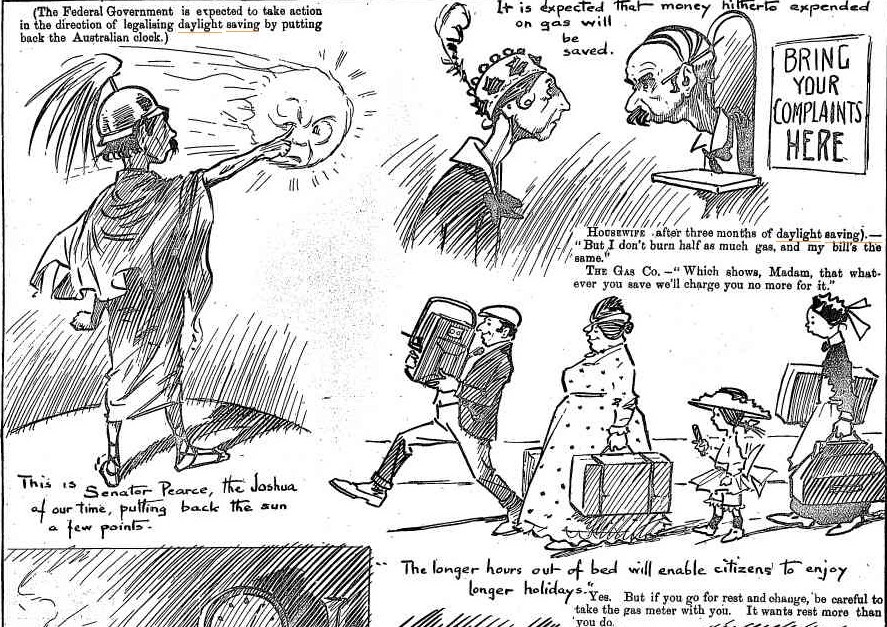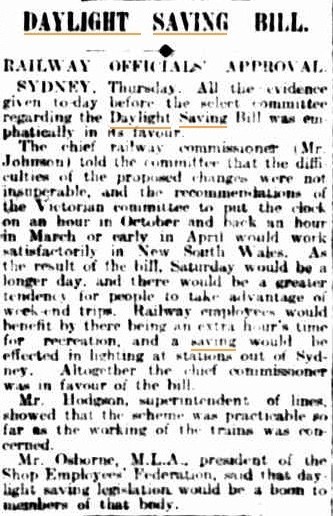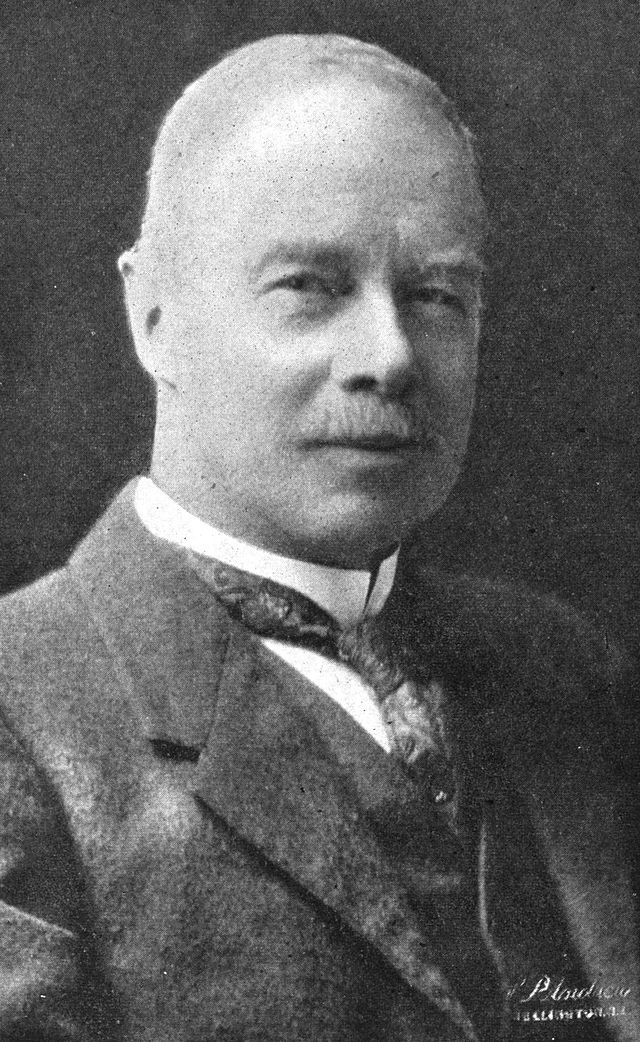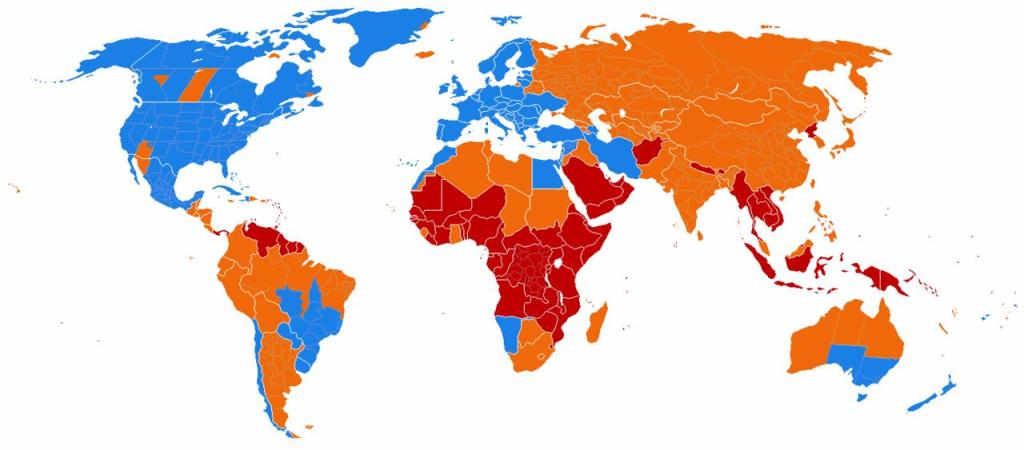October 5 - 11, 2014: Issue 183
Daylight Saving – A Few Notes from the Past
Daylight Saving In Australia was discussed as early as the turn of two centuries ago but Tasmania was the first to introduce a season of Daylight Saving – initially for ‘healthful reasons’ alongside following a European notion to save coal, and electricity, or other fuel during WWI.

DAYLIGHT SAVING. (1916, June 1). Punch (Melbourne, Vic. : 1914 - 1918), p. 22. Retrieved from http://nla.gov.au/nla.news-article130039505
Viewed as slightly ludicrous initially during an era and time when the notion of limits or sustaining resources was not part of our thinking, Daylight Saving did commence in Tasmania on Sunday October 1st, 1916.
 Right: DAYLIGHT SAVING BILL. (1911, November 17). The Argus(Melbourne, Vic. : 1848 - 1957), p. 11. Retrieved from http://nla.gov.au/nla.news-article11632719
Right: DAYLIGHT SAVING BILL. (1911, November 17). The Argus(Melbourne, Vic. : 1848 - 1957), p. 11. Retrieved from http://nla.gov.au/nla.news-article11632719
DAYLIGHT SAVING - OUR Hobart correspondent telegraphed last night: the Tasmanian Commercial Association has approved of the Daylight Saving Bill. DAYLIGHT SAVING. (1916, August 24). Daily Telegraph(Launceston, Tas. : 1883 - 1928), p. 4. Retrieved from http://nla.gov.au/nla.news-article152766041
DAYLIGHT SAVING - A proclamation fixing September 30 as the date upon which the Daylight Saving Act shall come into operation in Tasmania was approved by the Governor-in-Council yesterday. DAYLIGHT SAVING. (1916, September 23). Daily Telegraph(Launceston, Tas. : 1883 - 1928), p. 6. Retrieved fromhttp://nla.gov.au/nla.news-article152776694
1 Oct 1916 - Daylight Saving Time - Tasmania - When local standard time was about to reach: Sunday, 1 October 1916, 2:00:00 AM clocks were turned forward 1 hour to - Sunday, 1 October 1916, 3:00:00 AM local daylight time instead; Sunrise and sunset was about 1 hour later on 1 Oct 1916 than the day before. There was more light in the evening.
The other states of Australia, through the Federal Daylight Saving Act of December 21st, 1916, then followed suit on the 1st of January, 1917.... and within months:
DAYLIGHT SAVING. It is the intention of the Federal Government to repeal the Daylight Saving Act soon after the reassembling of the new Parliament. This was a measure that, curiously enough, had the support of every section of Parliament when it was introduced. After a short trial, however, there appeared to be some doubt as to its success, chiefly owing to its effect upon that section of the community, both in town and country, which is compelled to rise early. Mr Hughes stated that as there appeared to be no demand for the measure it had been decided to repeal it. DAYLIGHT SAVING. (1917, May 29). Ararat Chronicle and Willaura and Lake Bolac Districts Recorder (Vic. : 1914 - 1918), p. 2. Retrieved from http://nla.gov.au/nla.news-article154268449
Date of Assent: 21 Dec 1916, Date of Ceasing: Ceased, 25 Sep 1917, Reason for Ceasing Repealed by Daylight Saving Repeal Act 1917
Although the Daylight Saving Act was repealed soon after being first introduced, some states, like Tasmania which had introduced its own Act, continued to use the scheme and discussions on its usefulness continued. It was not until WWII scarcity, and mindfulness to make the best use of what resources there were, that Daylight Saving once more became useful for Australia.
In 1944 Daylight Saving again ceased and it wasn’t until 1967, and in Tasmania once more, that Daylight Saving again was introduced. In 1971 VIC, NSW, ACT, SA, TAS, QLD also began using Daylight Saving and in 1974 year Western Australia also had Daylight Saving, but only for that year.
The 1992-93 Summer season began what is still in place today with TAS, VIC, ACT, NSW, SA being the states that still utilise getting the most out of the season while QLD, the NT and WA abstain.’
DAYLIGHT SAVING?
The Government has announced that it does not intend to interfere with the Daylight Saving Act; but efforts are being made by some people to prevent it becoming operative again during the coming summer. It is, however, difficult to discover amongst the contention of its opponents sound and tenable reasons why it should not continue to be a source of convenience, economy, and pleasure to the people of Tasmania. A correspondent objects to daylight saving on the grounds that it is in vogue in Germany, and consequently ought to be tabooed here. But the Germans do many things which even nature compels people in other countries to do also. In normal times the Germans eat, drink, take exercise, engage in business, and indulge in various kinds of enjoyment. They are doubtless doing so now as extensively as the conditions of war permit. The people of the Allied nations not only do the same as the Germans in these and other ways but have daylight saving too. In Britain the Daylight Saving Act was introduced to Parliament in bill form as a measure of national economy by which a saving of at least two and a half millions sterling was expected. Only two members of the House of Commons voted against it. It has been found so generally beneficial a provision that there is no talk thereof abandoning it. The 'Journal' of the American Medical Association, when a bill to provide for what the British people prefer to call Summer Time was passing through Congress, pointed out that the suggestion that the clock be advanced one hour, or even two hours, during the summer months, was made long before the great war began, but no action was taken in any country. 'This,' remarked the 'Journal,'' 'is not to be wondered at, as the chief beneficiaries of the plan would be the unorganized public. Since the war has put a premium on the efficiency of the masses, and has also put a premium on coal and the power derived from these products, most of the European nations have adopted the plan of advancing the clock one hour. The daylight saving plan has, from a health standpoint, everything in its favor, and nothing against it.' We know that some people have complained that daylight saving, or summer time, in Tasmania is inconvenient. But there is good reason to believe that by the great majority of Tasmanians it has been found well worth having. One kind of objection submitted against it here is that while it is admitted, to be good for the people resident in cities and towns it is not so for people in the country districts. If we may judge by the discussion and voting at Municipal Council meetings it has lately been dealt with from the country districts point of view public opinion in those parts of the State is certainly nothing but unanimous against daylight saving. There is, however, something like prejudice against it in some quarters, and it is understood that an effort will again be made to induce Parliament to abolish it. Thus it is desirable that those who desire to continue to enjoy the benefits of healthful and economical summer time should bestir themselves to preserve the Act. DAYLIGHT SAVING. (1918, July 20). Daily Telegraph(Launceston, Tas. : 1883 - 1928), p. 6. Retrieved from http://nla.gov.au/nla.news-article152971009
DAYLIGHT SAVING.CANBERRA, Nov. 18.-The Commonwealth Government has agreed to consider the advisability of instituting a daylight saving scheme for Australia. The Prime Minister (Mr. Lyons) made this statement today in reply to a question asked by Mr. Jennings (U.A.P., NS.W.). DAYLIGHT SAVING. (1938, November 19). The West Australian(Perth, WA : 1879 - 1954), p. 22. Retrieved from http://nla.gov.au/nla.news-article46494055
Daylight saving time (DST) is the practice of advancing clocks during summer months (that feature more daylight) so that people get up earlier in the morning and experience more daylight in the evening.
Although they did not fix their schedules to the clock in the modern sense, ancient civilizations adjusted daily schedules to the sun more flexibly than modern DST does, often dividing daylight into twelve hours regardless of day length, so that each daylight hour was longer during summer. For example, Roman water clocks had different scales for different months of the year: at Rome's latitude the third hour from sunrise, hora tertia, started by modern standards at 09:02 solar time and lasted 44 minutes at the winter solstice, but at the summer solstice it started at 06:58 and lasted 75 minutes. After ancient times, equal-length civil hours eventually supplanted unequal, so civil time no longer varies by season. Unequal hours are still used in a few traditional settings, such as some Mount Athos monasteries and all Jewish ceremonies.
During his time as an American envoy to France, Benjamin Franklin, publisher of the old English proverb, "Early to bed, and early to rise, makes a man healthy, wealthy and wise", wrote in April, 1784, the 'Economical Project for Diminishing the Cost of Light' for the Journal de Paris . This 1784 satire proposed taxing shutters, rationing candles, and waking the public by ringing church bells and firing cannons at sunrise. Franklin did not propose DST; like ancient Rome, 18th-century Europe did not keep precise schedules. However, this soon changed as rail and communication networks came to require a standardization of time unknown in Franklin's day.
 Modern DST was first proposed by theNew Zealand entomologist George Vernon Hudson, whose shift-work job gave him leisure time to collect insects, and led him to value after-hours daylight. In 1895 he presented a paper to the Wellington Philosophical Society proposing a two-hour daylight-saving shift, and after considerable interest was expressed in Christchurch, New Zealand, he followed up in an 1898 paper. Many publications credit DST's proposal to the prominent English builder and outdoorsman William Willett, who independently conceived DST in 1905 during a pre-breakfast ride, when he observed with dismay how many Londoners slept through a large part of a summer's day. An avid golfer, he also disliked cutting short his round at dusk. His solution was to advance the clock during the summer months, a proposal he published two years later. The proposal was taken up by the Liberal Member of Parliament(MP) Robert Pearce, who introduced the first Daylight Saving Bill to the House of Commons on 12 February 1908. A select committee was set up to examine the issue, but Pearce's bill did not become law, and several other bills failed in the following years. Willett lobbied for the proposal in the UK until his death in 1915.
Modern DST was first proposed by theNew Zealand entomologist George Vernon Hudson, whose shift-work job gave him leisure time to collect insects, and led him to value after-hours daylight. In 1895 he presented a paper to the Wellington Philosophical Society proposing a two-hour daylight-saving shift, and after considerable interest was expressed in Christchurch, New Zealand, he followed up in an 1898 paper. Many publications credit DST's proposal to the prominent English builder and outdoorsman William Willett, who independently conceived DST in 1905 during a pre-breakfast ride, when he observed with dismay how many Londoners slept through a large part of a summer's day. An avid golfer, he also disliked cutting short his round at dusk. His solution was to advance the clock during the summer months, a proposal he published two years later. The proposal was taken up by the Liberal Member of Parliament(MP) Robert Pearce, who introduced the first Daylight Saving Bill to the House of Commons on 12 February 1908. A select committee was set up to examine the issue, but Pearce's bill did not become law, and several other bills failed in the following years. Willett lobbied for the proposal in the UK until his death in 1915.
Starting on 30 April 1916, Germany and its World War I ally Austria-Hungary were the first to use DST (German: Sommerzeit) as a way to conserve coal during wartime. Britain, most of its allies, and many European neutrals soon followed suit. Russia and a few other countries waited until the next year and the United States adopted it in 1918.
Broadly speaking, Daylight Saving Time was abandoned in the years after the war (with some notable exceptions including Canada, the UK, France, and Ireland for example). However, it was brought back for periods of time in many different places during the following decades, and commonly during the Second World War. It became widely adopted, particularly in North America and Europe starting in the 1970s as a result of the 1970s energy crisis.
Since then, the world has seen many enactments, adjustments, and repeals.
Daylight saving time. (2014, October 1). In Wikipedia, The Free Encyclopedia. Retrieved from http://en.wikipedia.org/w/index.php?title=Daylight_saving_time&oldid=627751257

Above: DST is used, DST is no longer used, DST has never been used.
Daylight Saving - A Few Notes from the Past - Collected and Collated by A J Guesdon, 2014.